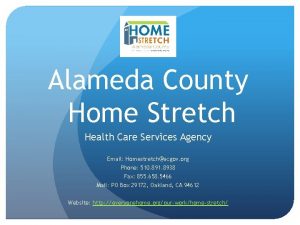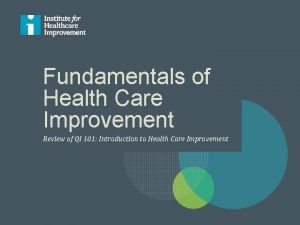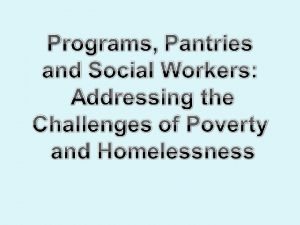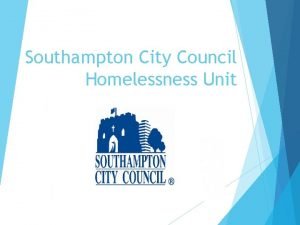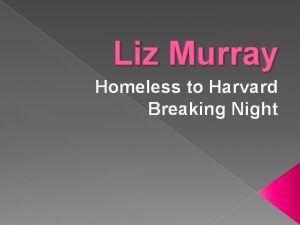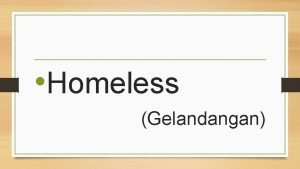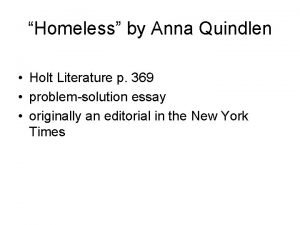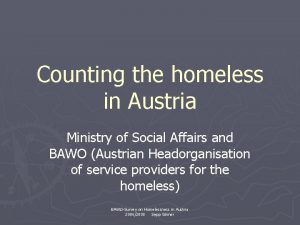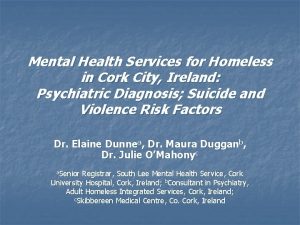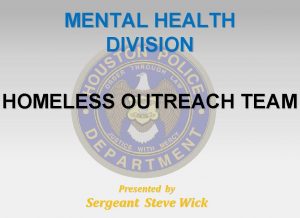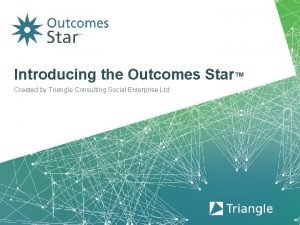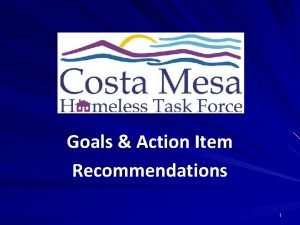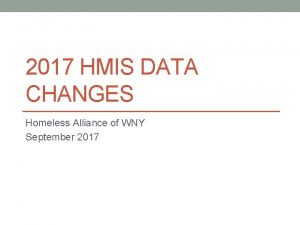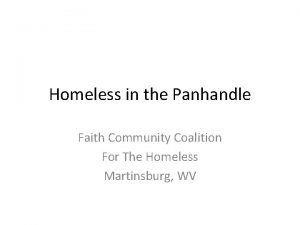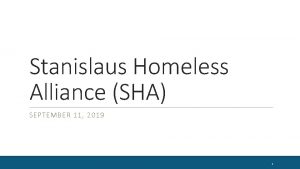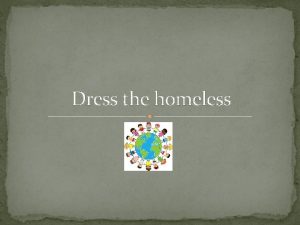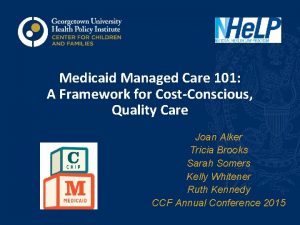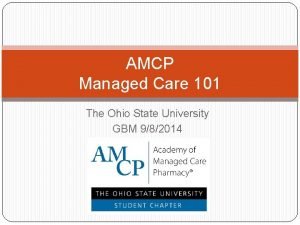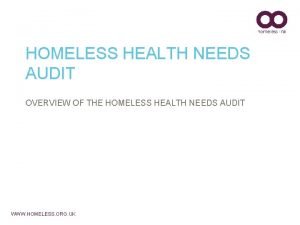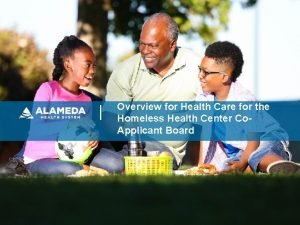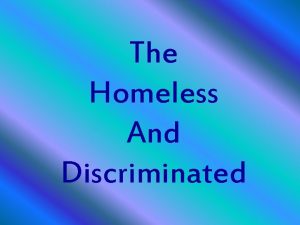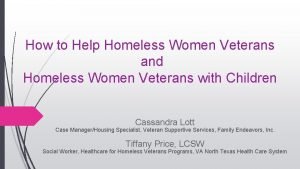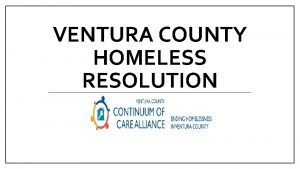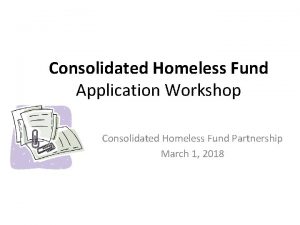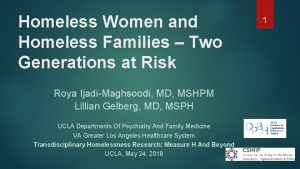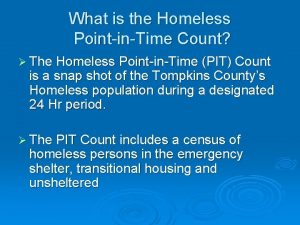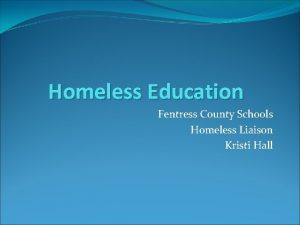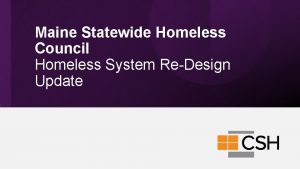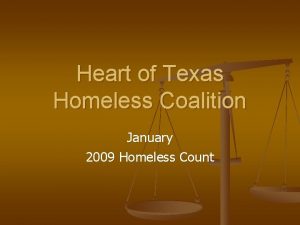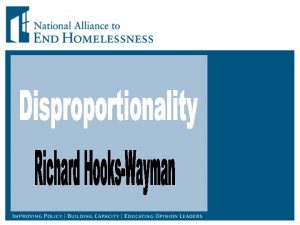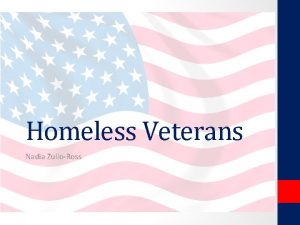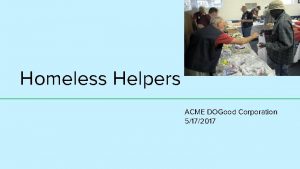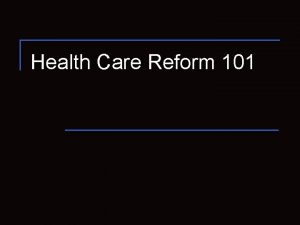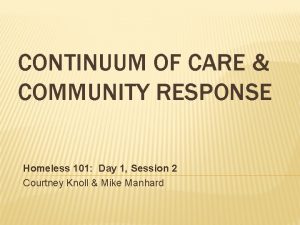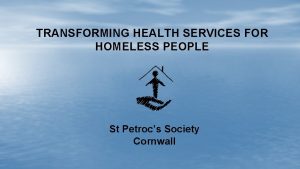Health Care for Homeless People 101 Presented to























































- Slides: 55

Health Care for Homeless People 101 • Presented to the Board of Directors of Fourth Street Clinic • July 17, 2008 at Grace Mary Manor • For its 2008 Board Retreat

Definition of homelessness The term ''homeless individual'' means an individual who lacks housing (without regard to whether the individual is a member of a family), including an individual whose primary residence during the night is a supervised public or private facility that provides temporary living accommodations and an individual who is a resident in transitional housing. --Public Service Health Act, Section 330(h)(5)(A) A homeless person is an individual without permanent housing who may live on the streets; stay in a shelter, mission, single room occupancy facilities, abandoned building or vehicle; or in any other unstable or non-permanent situation. A recognition of the instability of an individual's living arrangements is critical to the definition of homelessness. --Bureau of Primary Health Care, HCH Principles of Practice, Program Assistance Letter 99 -12

Numbers • Number of Homeless Persons Annually: 3. 5 million • Number of Homeless Persons Nightly: 842, 000 • Number of Americans Who Have Experienced Homelessness: 12 million Source: ~Urban Institute. What Will It Take to End Homelessness? 2001.

Demographics • Health Care for the Homeless Demographics • Male 58% (SLC = 65%) Female 42% (SLC = 35%) • Age 14 and under: 11% Age 15 to 19: 4% Age 20 to 44: 52% Age 45 to 64: 30% Age 65 and over: 2% Caucasian: 38% African American: 37% Hispanic: 22% Asian/Pacific Islander: 2% Native American/Alaskan Native: 2% • -Bureau of Primary Health Care, 2004 Uniform Data System

Insurance coverage • HCH Client Resources • Uninsured: 71% (We are currently at 90%) Medicaid: 23% (We are at 10%) Medicare: 3% (We are at 1%) Other public insurance: 2% Private Insurance: 2% Below 200% Federal Poverty Level: 99% • -Bureau of Primary Health Care, 2004 Uniform Data System

Life Expectancy • Life Expectancy US Population: 77 years Homeless in Boston: 47 years Homeless in Atlanta: 44 years Homeless in San Francisco: 41 years • Homeless in Salt Lake City: 47 years • [Discuss Bad interpretation of data]

Origins of HCH • Soon after the dramatic increase of homelessness in the 1980’s, health care professionals, shelter providers, advocates, government agencies and homeless people themselves recognized that a concerted health care response was required. A successful 4 -year Health Care for the Homeless demonstration program, operated in 19 cities with financial support from the Robert Wood Johnson Foundation and the Pew Charitable Trust, was replicated in the Stewart B. Mc. Kinney Homeless Assistance Act of 1987. • The Health Resources and Services Administration, which administers the federal Health Care for the Homeless (HCH) Program authorized by this legislation, began funding homeless health projects in 1988.

Community focused • By 2001, HCH projects existed in every State, the District of Columbia, and Puerto Rico. HCH projects are created and operated by the communities they serve, are widely heralded as a smart and effective approach to homelessness, and continue to emerge in additional communities as the Consolidated Health Center Program of which they are part continues to expand.

2005 numbers • As of June 2005, 177 HCH grantees of the Health Resources and Services Administration (HRSA) were providing health and social services to more than 600, 000 clients per year. These projects typically operate as part of Community and Migrant Health Centers, hospitals, or Departments of Public Health, or as freestanding agencies. Most combine HRSA funding with other revenue and grants to provide a broad range of services.

Required services • At a minimum, each project provides a prescribed set of required services, including primary health care and substance abuse services, emergency care and referrals, outreach and assistance in qualifying for entitlement programs and housing. Many HCH projects go well beyond these basic services, offering dental care, mental health treatment, sub-acute recuperative care, supportive housing, and other services needed to resolve their clients’ homelessness.

Roots of homelessness • Health Problems Cause Homelessness. Half of all personal bankruptcies in the United States result from health problems, and it is a short downhill slide from bankruptcy to eviction to homelessness. Moreover, some health problems are more prevalent among homeless people than in the general population – such as addictions, mental illnesses and HIV/AIDS – are known to undermine family and social supports that provide a bulwark against homelessness for many vulnerable people.

Homeless = health care problems • Homelessness Causes Health Problems. People without homes are mercilessly exposed to the elements, to violence, to communicable diseases and parasitic infestations. Circulatory, dermatological and musculoskeletal problems are common results of excessive walking, standing, and sleeping sitting up. • Homelessness and malnutrition go hand-in-hand, increasing vulnerability to acute and chronic illnesses. Stresses associated with homelessness also reduce resistance to disease, account for the emergence of some mental illnesses, and enhance the false promises of relief offered by alcohol and drugs. • Homeless people experience illnesses at three to six times the rates experienced by housed people.

NHCHC Studies • HOMELESS CHILDREN AND ADOLESCENTS • Title: A Longitudinal Study of Early Adolescent Precursors to Running Away • Authors: Tyler KA, Bersani BE • Source: Journal of Early Adolescence, 28(2): 230 -251, May 2008.

Results: • • • being female neighborhood victimization personal victimization school suspension and delinquency all significantly increased the expected frequency of running away.

Gender Issues • Title: Interaction of Duration of Homelessness and Gender on Adolescent Sexual Health Indicators • Authors: Rew L, Grady M, Whittaker TA, Bowman K • Source: Journal of Nursing Scholarship, 40(2): 109 -115, 2008.

Con’t • • • both boys and girls who had been homeless > 1 year had greater AIDS knowledge, reported significantly more sexual risk-taking behaviors, and engaged in fewer safe-sex behaviors than did those who had been homeless < 6 months. female participants had significantly lower levels of perceived health status, significantly greater sexual self-care behaviors, and significantly higher levels of assertive communication than did male participants, regardless of duration of homelessness. The duration of homelessness and gender has both direct and interaction effects on cognitive-perceptual and behavioral outcomes associated with sexual health. Nurses and other healthcare providers working with homeless youth recognize the need to develop brief interventions that address healthrisk behaviors. gender-specific interventions should be provided to youth soon after they become homeless.

Con’t • Title: Toward a Needs-Based Typology of Homeless Youth • Author: Bucher CEC • Source: Journal of Adolescent Health, 42(6): 549 -554, Jun 2008. • Seven risk categories were identified in the literature: • abusive experiences, involvement in prostitution, involvement in criminal activities, suicidal ideation/attempt, living circumstances, alcohol/marijuana use, and the use of drugs other than alcohol and marijuana.

Risky behavior among youth • Title: Individual and Environmental Protective Factors for Risky Sexual Behavior among Homeless Youth: An Exploration of Gender Differences • Authors: Trevendale HD, Lightfoot M, Slocum SL • Source: AIDS and Behavior, Jun 6, 2008.

Child abuse • Title: Child Abuse in Blended Households: Reports from Runaway and Homeless Youth • Author: Mc. Ree N • Source: Child Abuse and Neglect, 32(4): 449 -453, Apr 2008.

Con’t • Title: Correlates of Substance Use among Homeless Youths in • Eight Cities • Authors: Salomonsen-Sautel S, Van Leeuwen JM, Gilroy C, Boyle S, Malberg D, Hopfer C • Source: The American Journal on Addictions, 17(3): 224 -234, May-Jun 2008.

Meth • Title: Circumstances of First Crystal Methamphetamine Use and Initiation of Injection Drug Use among High-Risk Youth • Authors: Wood E, Stoltz JA, Zhang R, Strathdee SA, Montaner JS, Kerr T • Source: Drug and Alcohol Review, 27(3): 270 -276, May 2008.

Results of this study: • The study results are consistent with prior research that shows the presence of a non-related parent figure in a household is associated with a greater than expected risk of sexual or physical abuse to children. However, the findings suggest that the particular role or status of nonrelated parents may not be a meaningful risk factor when considering intervention strategies in suspected cases of abuse in blended households. • The sample probably represents family conditions that are significantly worse for children than what would be found in the general population, and thus the results of this study should not be generalized to the population at large.

Infectious Disease and Homelessness • Title: Homelessness and the Response to Emerging Infectious Disease Outbreaks: Lessons from SARS • Authors: Leung CS, Ho MM, Kiss A, Gundlapalli AV, Hwang SW • Source: Journal of Urban Health Bulletin of the New York Academy of Medicine, 85(3): 402 -410, May 2008.

Preparedness Plans • Although no homeless individual in Toronto contracted SARS, the outbreak highlighted the need to develop an outbreak preparedness plan that accounts for unique issues related to homeless people.

Con’t • Planning for future outbreaks should take into account the need to • (1) develop systems that enable rapid two-way communication between public health officials and homeless service providers, • (2) ensure that homeless service providers have access to infection control supplies and staff training, • (3) prepare for possible homeless shelter closures due to staff shortages or high attack rates among clients, and • (4) plan for where and how clinically ill homeless individuals will be isolated and treated.

HBV Issues • Title: Prevalence and Correlates of Previous Hepatitis B Vaccination and Infection among Young Drug-Users in New York City • Authors: Amesty S, Ompad DC, Galea S, Fuller CM, Wu Y, Koblin B, Vlahov D • Source: Journal of Community Health, 33(3): 139 -148, Jun 2008.

Con’t • Hepatitis B (HBV) vaccination coverage remains low among drug users. • Among 399 DUs younger than 25 years of age, 30% demonstrated serological evidence of previous vaccination, 49. 9% were susceptible to HBV at baseline, and 20% showed evidence of infection.

Con’t • Among 812 DUs 25 and older, 10. 6% demonstrated serological evidence of previous vaccination, • 59. 2% were susceptible to HBV at baseline, • and 30. 2% showed evidence of infection.

Influenza Vaccination Rates • Title: Project VIVA: a Multilevel Community. Based Intervention to Increase Influenza Vaccination Rates among Hard-to-Reach Populations in New York City • Authors: Coady MH, Galea S, Blaney S, Ompad DC, Sisco S, Vlahov D; Project Viva Intervention Working Group • Source: American Journal of Public Health, 98(7): 1314 -1321, May • 29, 2008.

HCV Infection • Title: Seroprevalence of HCV Infection in Homeless Baltimore Families • Authors: Schwarz KB, Garrett B, Alter MJ, Thompson D, Strathdee SA • Source: Journal of Health Care for the Poor and Underserved, 19(2): 580 -587, May 2008.

Moving back to housing • TRANSITIONING TO HOUSING • Title: From Homeless to Housed: Caring for People in Transition • Author: Drury LJ • Source: Journal of Community Health Nursing, 25(2): 91 -105, Apr-Jun 2008.

Finally an Ethnography This ethnographic study was conducted to determine what homeless people experience during the transition from street life into community housing. Data were gathered through participant observation at a program designed to secure housing and support services for homeless people upon discharge from a psychiatric hospital. Sixty homeless, mentally ill adults were followed from hospital discharge through their first 2 years in community housing. Homeless people interact with health care providers across a cultural divide produced by vast differences in their lived experiences. This cultural distance limits access to the services that these individuals require to achieve residential stability.

Special Populations within Special Populations • HOMELESS WOMEN • Title: Ladies' Night: Evaluating a Drop-In Programme for Homeless and Marginally Housed Women in San Francisco's Mission District • Authors: Magee C, Huriaux E • Source: International Journal of Drug Policy, 19(2): 113 -121, Apr 2008.

Con’t • Gender, race, class, and sexuality create a unique set of requirements for addressing HIV risk among homeless and marginally housed (HMH) women. • Though studies have recommended both individual and structural prevention strategies tailored to meet the expansive needs of this community, there is a paucity of research on interventions specific to HMH women.

Domestic Violence • Title: Profiles of Behavioral Problems in Children Who Witness Domestic Violence • Authors: Spilsbury JC, Kahana S, Drotar D, Creeden R, Flannery DJ, Friedman S • Source: Violence and Victims, 23(1): 3 -17, 2008.

Con’t • Comparison across demographic and violence characteristics revealed that the profiles differed by child gender, mother's education, child's lifetime exposure to violence

Violence and Mental Health • Title: Characteristics of Recent Violence among Entrants to Acute Mental Health and Substance Abuse Services • Authors: Mericle AA, Havassy BE • Source: Social Psychiatry and Psychiatric Epidemiology, 43(5): 392 -402, May 2008.

Con’t • The aim of this study was to describe the characteristics of recent interpersonal violence perpetrated and experienced by individuals recruited from acute crisis mental health and substance abuse treatment settings and to examine differences among incidents involving individuals with mental disorders only (MDO), substance use disorders only (SDO), and cooccurring mental and substance use disorders (COD)

Con’t • Participants were also asked about where each incident took place, who was involved, whether individuals were injured, and whether alcohol or drugs were used before the incident. • Participants used drugs or alcohol prior to over 40% of incidents. • Most incidents of perpetration (70%) targeted someone known to the participant.

Con’t • Violence is common among individuals entering acute crisis mental health and substance abuse treatment. • Such persons are more likely to report being victims of violence than perpetrators of violence. • Most incidents took place outdoors.

Alcohol and Drugs • Title: Health Status and Access to Care for Homeless Adults with Problem Alcohol and Drug Use • Authors: Savage C, Gillespie GL, Lindsell CL • Source: Journal of Addictions Nursing, 19(1): 27 -33, 2008.

Con’t • Problem alcohol and drug use by adult homeless persons may put them at higher risk for other health problems and impact their access to health care. • The purpose of this study was to determine if those with a positive screen for problem alcohol or drug use were at increased odds for having a lower health status and less access to care than those without problem alcohol or drug use.

Con’t • Participants with problem alcohol use tended to be less likely to obtain health care when needed. • Those with problem alcohol or drug use were not at increased odds of reporting a lower general health status, a positive medical history, or ED use. • Problem alcohol use was associated with decreased access to health care when needed. • Screening for problem alcohol use among homeless adults may not only help to identify those in need of interventions related to alcohol use but also help to identify those in need of help in accessing general health care.

Treatable moments • Title: The Health Encounter as a Treatable Moment for Homeless Substance-Using Adults: The Role of Homelessness, Health Seeking Behavior, Readiness for Behavior Change and Motivation for Treatment • Authors: O�� Toole TP, Pollini RA, Ford DE, Bigelow G • Source: Addictive Behavior, May 9, 2008. [Epub ahead of print]

Con’t • Summary: Substance-using homeless persons frequent emergency departments and hospitals often. • However, little is known about how homelessness affects when they seek care and their motivation for substance abuse treatment (SAT).

Con’t • We surveyed homeless (N=266) and non homeless (N=104) substance-using adults sequentially admitted to an urban hospital medicine service, comparing demographics, readiness for change (URICA), and motivating reasons for SAT (substance abuse treatment). • Homeless respondents were more likely to be younger, uninsured, have hepatitis B/C, and <12 th grade education.

Con’t • Almost half reported that being homeless caused them to delay seeking health care; paradoxically those citing physical health as a SAT motivator were 3. 4 times more likely to have delayed care. • While acutely ill homeless persons were at least as motivated for SAT, these data suggest the challenge is getting them to care in a timely manner and tailoring interventions during the care episode to avail of this motivation.

Hunger and homelessness • Title: Homelessness and Hunger • Authors: Lee BA, Greif MJ • Source: Journal of Health and Social Behavior, 49(1): 3 -19, Mar 2008.

I want to be fair here, but … • Summary: We employ data from the National Survey of Homeless Assistance Providers and Clients to examine the character and correlates of hunger among homeless people. Our analysis, couched in an adaptation framework, finds more support for the differentiation hypothesis than for the leveling hypothesis: Complex patterns of food insecurity exist at the individual level, and they vary with the resources available (e. g. , higher monthly income, regular shelter use) and obstacles faced (e. g. , alcohol, drug, and physical and mental health problems). The chronically homeless, who suffer from multiple deficits, appear particularly food-insecure, a finding that favors the desperation hypothesis over its street-wisdom alternative. We conclude that hunger is not uniformly experienced by members of the homeless population. Rather, some individuals are better situated than others to cope with the stressful nature of homelessness when addressing their sustenance needs.

Health status • Title: Survey Findings on Characteristics and Health Status of Clients Treated by the Federally Funded (US) Health Care for the Homeless Programs • Authors: Zlotnick C, Zerger S • Source: Health and Social Care in the Community, Jun 17, 2008.

Con’t • Summary: For almost two decades, the US Health Care for the Homeless (HCH) Program has funded clinics across the country for homeless populations. Between October and December 2003, for the first time ever, a nationally representative sample of the almost 200 HCH clinics with a response rate of approximately 71% (the HCH User Visit Survey) was created to examine the health status of its users (n = 1017). This study employed the HCH User Visit Survey's cross-sectional data set to evaluate health indicators of individuals using HCH Services with the US population, and compare individuals who reported they routinely used HCH clinics ('usual' HCH users) to those who did not ('nonusual‘ users). HCH users had poorer health status than the US population (44. 0% versus 12. 3%, respectively).

Con’t • Usual HCH users had similar healthcare status compared to non-usual users, but were more likely to be uninsured, non-English speakers, and walking or taking public transportation to their medical appointments. Usual versus non-usual HCH users were also more apt to have slept in cars, buses or on the streets in the week prior to the survey (14. 8% versus 4. 3%, respectively). This study shows that the HCH clinics are serving homeless individuals who have a variety of complex health and psychosocial needs, and its most frequent users are those who experience the most barriers accessing care.

Elderly Issues Title: Medical Care for the Homeless Elderly • Author: Horn A • Source: Care Management Journal, 9(1): 25 -30, 2008.

Con’t • Summary: This is a case study of two elderly, frail women in New York City who were recently rendered homeless. One woman had a massive tumor on her occipital scalp; the other was in renal failure. • The obstacles and complexities of providing care to hose with double jeopardy--being elderly and h omeless are described. There are enormous difficulties for placement into safe, supportive housing once people become homeless. The process is expensive and labor intensive. This can be complicated by the existence of mental illness.

Con’t • There are systemic obstacles as well: One woman loses her Medicaid when she moves from one state to another to be closer to her family. • Another, 82 years old, is told to get a job so that she could qualify for Medicare. There are numerous contradictions and unnecessary costs in a fragmented health care system to which the obvious solution is a national single-payer system of care.
 Alameda county health care for the homeless
Alameda county health care for the homeless L101 introduction to healthcare leadership
L101 introduction to healthcare leadership Health care 101
Health care 101 Qi 101: introduction to health care improvement
Qi 101: introduction to health care improvement Primary secondary tertiary medical care
Primary secondary tertiary medical care Care value base health and social care
Care value base health and social care Health and social care component 3 health and wellbeing
Health and social care component 3 health and wellbeing Was will smith homeless
Was will smith homeless Southampton city council housing
Southampton city council housing Homeless to harvard summary
Homeless to harvard summary Homeless artinya
Homeless artinya Homeless by anna quindlen
Homeless by anna quindlen Homelessness in austria
Homelessness in austria Hunchback in the park analysis
Hunchback in the park analysis Homeless shelters southend
Homeless shelters southend Homeless services cork
Homeless services cork Hpd mental health division
Hpd mental health division Outcome star homelessness
Outcome star homelessness Costa mesa homeless
Costa mesa homeless Hmis wny
Hmis wny Chronically homeless orange county
Chronically homeless orange county Thomas benjamin kennington homeless
Thomas benjamin kennington homeless Homeless coalition martinsburg wv
Homeless coalition martinsburg wv Stanislaus homeless alliance
Stanislaus homeless alliance Homeless dressing
Homeless dressing Michael oher homeless
Michael oher homeless 101 ways to annoy people
101 ways to annoy people Managed care 101
Managed care 101 Managed care 101
Managed care 101 Amcp-101
Amcp-101 Iso 22301 utbildning
Iso 22301 utbildning Novell typiska drag
Novell typiska drag Tack för att ni lyssnade bild
Tack för att ni lyssnade bild Returpilarna
Returpilarna Varför kallas perioden 1918-1939 för mellankrigstiden?
Varför kallas perioden 1918-1939 för mellankrigstiden? En lathund för arbete med kontinuitetshantering
En lathund för arbete med kontinuitetshantering Adressändring ideell förening
Adressändring ideell förening Tidbok för yrkesförare
Tidbok för yrkesförare Anatomi organ reproduksi
Anatomi organ reproduksi Förklara densitet för barn
Förklara densitet för barn Datorkunskap för nybörjare
Datorkunskap för nybörjare Tack för att ni lyssnade bild
Tack för att ni lyssnade bild Debattartikel mall
Debattartikel mall Magnetsjukhus
Magnetsjukhus Nyckelkompetenser för livslångt lärande
Nyckelkompetenser för livslångt lärande Påbyggnader för flakfordon
Påbyggnader för flakfordon Lufttryck formel
Lufttryck formel Offentlig förvaltning
Offentlig förvaltning Jag har nigit för nymånens skära
Jag har nigit för nymånens skära Presentera för publik crossboss
Presentera för publik crossboss Teckenspråk minoritetsspråk argument
Teckenspråk minoritetsspråk argument Kanaans land
Kanaans land Klassificeringsstruktur för kommunala verksamheter
Klassificeringsstruktur för kommunala verksamheter Epiteltyper
Epiteltyper Bästa kameran för astrofoto
Bästa kameran för astrofoto Centrum för kunskap och säkerhet
Centrum för kunskap och säkerhet
